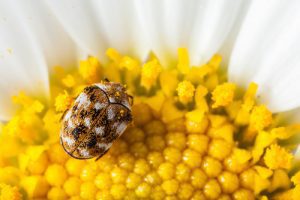Carpet Beetles Show Up in the Spring
By Chris Williams on March 1, 2011.
Q. In the past week, I’ve noticed several small, dark insects slowly crawling up the walls in the family room. They look like tiny beetles. Any idea what they’re doing in my house?
A. Those tiny beetles are probably carpet beetles. They’re small and round, only about the size of the head of a pin. They appear dark against a light wall but if you look at them closely you will see that they usually have a calico coloration of various browns, white, orange, and black. In the early spring, they crawl up walls or fly towards windows or lights looking for a way out of your house. But why are they in your house in the first place, you ask? Carpet beetles have an interesting life cycle.
Adult carpet beetles are common outdoors on flowering plants and shrubs where they feed on nectar and pollen, although they don’t do any visible feeding damage to the plant. After the carpet beetles mate outside in summer, the female avoids light and looks for a dark place to lay her eggs, often ending up inside a home. But these aren’t the same beetles you’re seeing climbing your walls now. The beetle larvae that hatch from the eggs do not feed on plants like the adult beetles. They feed instead on wool carpets, certain soiled fabrics, hides, felt, feathers, dead animals and insects, and occasionally on stored foods.
 In homes, the larvae are usually found wherever lint, pet hair, crumbs, and dead insects have accumulated – such as in corners, along baseboards, in air ducts, under furniture or rugs – especially in places that are rarely vacuumed like under heavy furniture. The larvae are very small and remain hidden in dark, out-of-the-way places. You can find them in stored woolens, stuffed furniture, stuffed animals, in dry pet food, or even feeding on a dead mouse in a wall void. You may not see the beetle larvae but you might find their shed skins. After they molt a number of times, the larvae pupate and turn into the adult beetles that you see climbing your walls trying to get outside.
In homes, the larvae are usually found wherever lint, pet hair, crumbs, and dead insects have accumulated – such as in corners, along baseboards, in air ducts, under furniture or rugs – especially in places that are rarely vacuumed like under heavy furniture. The larvae are very small and remain hidden in dark, out-of-the-way places. You can find them in stored woolens, stuffed furniture, stuffed animals, in dry pet food, or even feeding on a dead mouse in a wall void. You may not see the beetle larvae but you might find their shed skins. After they molt a number of times, the larvae pupate and turn into the adult beetles that you see climbing your walls trying to get outside.
Carpet beetle larvae eat slits in carpets and feed on the surface of fabrics, clipping fibers and creating holes. They clip the tips off of fur, hair, and bristles. Unless carpet beetles are infesting a carpet or a carcass, they are usually found in small numbers and can be controlled by frequent vacuuming, especially of areas where lint, hair, and crumbs accumulate. If you have a bigger problem, give Colonial a call.